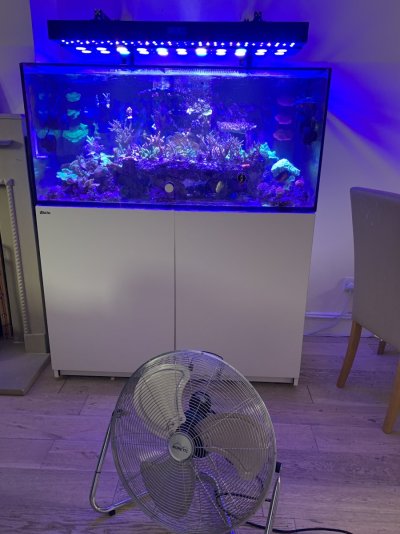Sea breezes at home: Have you ever used fans to impact flow?
When we think about fans and reef tanks, usually we are talking about cooling or about drying water on the floor (yet again!). These are both real issues – I can’t tell you how many times I have had water on the floor (RODI overflow anyone?) that needed to be dried up with towels and a fan. Additionally, tanks on the top end of the recommended temperature range (or above) have also cause many to add cooling fans. But have you ever thought about using fans to impact flow? In addition to cooling, creating water turbulence at the surface of the water can also provide other benefits such as oxygenation, moving surface water, and more. If you have ever used fans to create flow (either intentionally or not), please tell us about your experience in the related discussion thread.

Photo by @Epic Aquaculture; March 2024 Reef of the Month
This QOTD is sponsored by: www.deltecdirectusa.com

“With dozens of protein skimmers, calcium reactors, media reactors and kalkwasser stirrers in operation, Deltec USA can speak from experience and help you with all your Deltec needs. Live customer support and a large inventory of products rounds out our mission to provide the best possible Deltec experience.”
When we think about fans and reef tanks, usually we are talking about cooling or about drying water on the floor (yet again!). These are both real issues – I can’t tell you how many times I have had water on the floor (RODI overflow anyone?) that needed to be dried up with towels and a fan. Additionally, tanks on the top end of the recommended temperature range (or above) have also cause many to add cooling fans. But have you ever thought about using fans to impact flow? In addition to cooling, creating water turbulence at the surface of the water can also provide other benefits such as oxygenation, moving surface water, and more. If you have ever used fans to create flow (either intentionally or not), please tell us about your experience in the related discussion thread.
Photo by @Epic Aquaculture; March 2024 Reef of the Month
This QOTD is sponsored by: www.deltecdirectusa.com
“With dozens of protein skimmers, calcium reactors, media reactors and kalkwasser stirrers in operation, Deltec USA can speak from experience and help you with all your Deltec needs. Live customer support and a large inventory of products rounds out our mission to provide the best possible Deltec experience.”



















